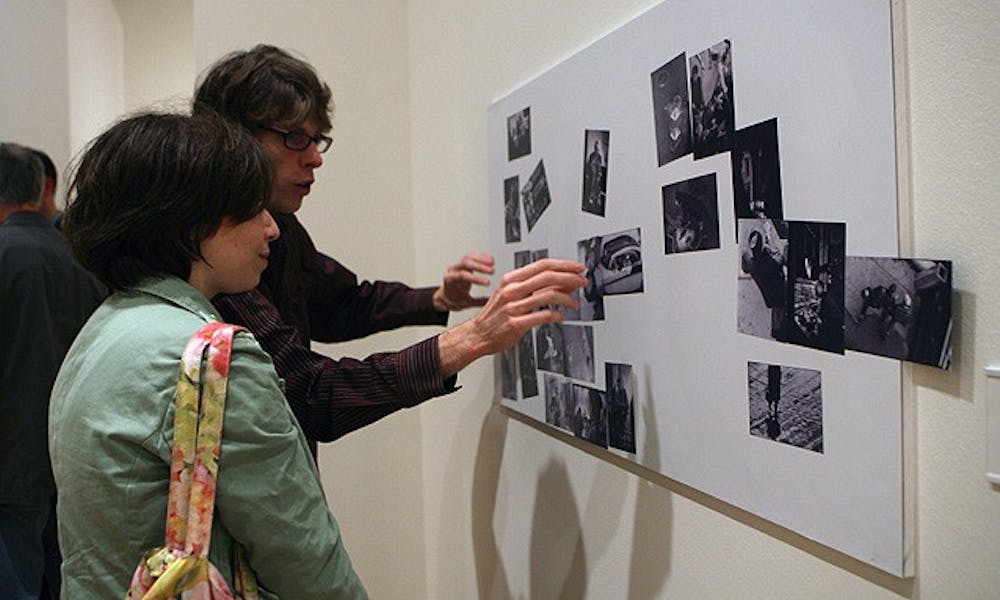Opened last night at the Nasher Museum of Art, The Jazz Loft Project: W. Eugene Smith in New York City, 1957-1965 is a remarkably realized recreation of a space and time.
The period left an indelible mark on American consciousness. Political tumultuousness coexisted alongside a golden age of jazz, and post-war documentary photography was burgeoning. Photojournalists like W. Eugene Smith rendered scenes both poignant and inelegant, contributing greatly to the national memory of a special era.
In 1955, Smith left Life magazine, and two years later he began a nine-year residence in a rundown five-story loft building, 821 6th Ave., nestled in a quiet, neglected area of Manhattan between the garment and flower districts.
His goal was to document the jazz music and bohemian culture of the era, a task he accomplished prodigiously—more than 40,000 photographs taken and 4,000 hours of audio recorded.
It’s with similar zeal that writer Sam Stephenson, director of the Jazz Loft Project at the Center for Documentary Studies, approached the ambitious task of listening to and cataloguing the entirety of Smith’s material; The Jazz Loft Project, which Stephenson co-curates with Courtney Reid-Eaton, exhibitions director at CDS, is a distillation of over a decade’s work.
Dan Partridge, a research associate for CDS, pored over the photographs and audio footage for years. The work of Patridge and his colleagues has already yielded a radio series and book, yet Partridge said he still doesn’t feel the possibilities of discovery have been exhausted.
“[The Jazz Loft Project] really gives you a sense of that time period, and also of Smith’s place in it,” Partridge said. “It’s so expansive you feel you could keep going with it, do another radio series, another book.”
In fact, there are still 900 hours of audio yet to be listened to. Still, the Nasher collection does feel immersive and is as close as a gallery exhibit can come to comprehensiveness. The display includes a plentiful range of black-and-white photographs, original recording equipment, copies of Life magazine and listening stations to stop and absorb the sounds through headphones.
The candid photos are voyeuristic, showing through a splintered windowpane a bird’s-eye view of street sweepers, traveling salesmen and drunks passing below. Ambient recordings of some of the jazz recordings play from overhead, in an effort to recreate the experience of stumbling upon the loft from the streets of Manhattan.
Among those who did “stumble” into the loft: veritable giants like Alice Coltrane and Thelonious Monk. Several tuned pianos available for impromptu jam sessions and plentiful space attracted legendary musicians and their contemporaries of more modest talents alike, Partridge said.
In fact, it’s the unextraordinary music, historical nobodies and tidbits of cultural milieu captured on the recordings—a recording of a radio show that allowed Southerners to voice opinions for and against African-American civil rights, for instance—that really embody the essence of the Project.
Trevor Schoonmaker, curator of contemporary art at the Nasher, said CDS is well suited to offer this historical perspective.
“They’re the experts. They’re the scholars. We’re helping [CDS] by amplifying what they do,” Schoonmaker said. “It’s a perfect partnership—a step away from conceptual fine art.”
Fittingly, The Jazz Loft Project is the labor of love by documentarians, not jazz aficionados.
“If we made a record of any building from that time period, it would have been almost as important,” Stephenson said. “That they happened to be playing jazz and include important people is almost a bonus.”
Stephenson’s words reflect the extraordinary, of-the-moment quality that gave electricity to the original Jazz Loft and now the exhibition. That its contents comprise documents of and produced by individuals from such disparate social backgrounds—black and white, photographer and musician, renowned and unknown—speaks to the interfusion of the time, something that the Jazz Loft epitomized.
Stephenson calls the multimedia project “a biography of a building”—but it’s a biography of American people as well
“That’s pre-Civil Rights, during a certain post-war honeymoon before the country got so divided politically,” Stephenson said. “It’s before people started moving out to the suburbs; a real moment when you could move to New York and get an apartment for $20 a month and you could make it. You rarely have access to the ordinary banal moments that make up a huge majority of our world history.”
The Jazz Loft Project runs through July 10, 2011 at the Nasher Museum of Art.
Get The Chronicle straight to your inbox
Signup for our weekly newsletter. Cancel at any time.

